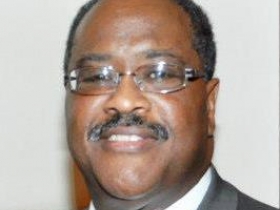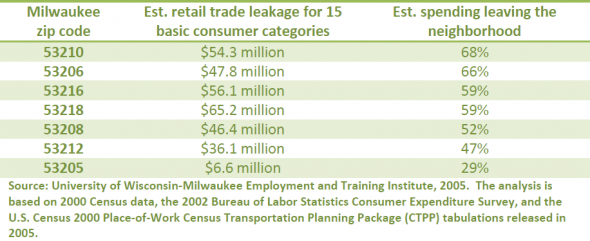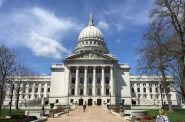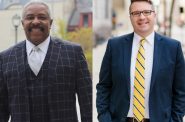The African American Advantage
The county’s black residents have $3.6 billion in annual income and black neighborhoods have far more purchasing power than suburbs.
Is it possible Walgreen’s knows something that other retail chains don’t? You can find a Walgreen’s on the north side at 27th and North, at 22nd and Capitol, on N. Hopkins, N. Teutonia and Martin Luther King Drive. You can find a Walgreen’s on the south side at 11th and Mitchell, 14th and Burnham and 24th and Forest Home.
But try to find a Pick’n’Save in certain black neighborhoods, or a Best Buy anywhere in the entire city. The central city is a desert when it comes to most kinds of retail stores. The assumption, of course, is that retail chains locate where they can sell more, in the wealthier neighborhoods. But that assumption is dead-wrong.
A new study by researcher Lois Quinn and the UW-Milwaukee Employment & Training Institute turns conventional wisdom on its head, finding that predominantly black and Latino inner-city neighborhoods have far more purchasing power than the wealthiest suburbs, for a very simple and obvious reason: density.
Based on household surveys by the U.S. Census Bureau, the study found that the 53206 zipcode, “generally viewed as the poorest neighborhood of Milwaukee,” generated $115.8 million in income per square mile in 2011. The total household income of African Americans in Milwaukee County was a $3.557 billion, with $2.56 billion of the total generated by nine zipcodes where African Americans make up a majority of the population.
While the average black household is less likely to have two wage earners than a white suburban household, the density of city blocks means there are far more wage earners per block. “Contrary to the persistent — and totally inaccurate — urban myth that children are growing up in central city neighborhoods where they see very few employed families, state tax returns show the highest concentration of working families in the central city,” the study notes.
The study found that in the poorest zipcode, 53206, there are 1,676 working families per square mile, compared to 137 per square mile in Franklin, 325 in the North Shore zipcode 53217, 443 in Saint Francis and 587 in South Milwaukee. This huge disparity in the number of wage earners gives even the poorest city neighborhood a huge advantage in purchasing power.
The study used the U.S. Census Bureau Consumer Expenditure Survey to estimate spending levels in city and suburban neighborhoods. Households in the 53206 zipcode spend $13.1 million per square mile for food from grocery and convenience stores, compared to just $1 million per square mile for Grafton, $2.4 million for Brookfield and $4.8 million for Greendale. Yet you will find far more grocery and convenience stores in the suburbs.

Randy Crump
They are missing a huge opportunity, says Randy Crump, the CEO of Prism Technical, and chair of the African American Chamber of Commerce. “Those stores that go into the inner city — and obviously they may have to spend some money on better security — are able to generate tremendous sales. There is a tremendous opportunity for commerce in the inner city.”
In numerous categories of retail spending, the 53206 zipcode is an economic powerhouse compared to outlying suburbs. It spends an estimated $973 per square mile for personal products (hair care, shaving needs, etc.), almost 15 times more than in Cedarburg, about 11 times more than Pewaukee and seven times more than Mequon/Thiensville. That difference may explain why you find so many Walgreens stores located in poorer city neighborhoods.
The 53206 zipcode spends 2 to 20 times more per square mile on apparel than various surrounding suburbs, 1.5 to 17 times more on TV and video-related purchases, up to 20 times more on home repair items, up to 10 times more for both non-prescription drugs and for computer hardware and software.
The potential market in predominantly black neighborhoods is huge, but they must go elsewhere to make their purchases. “You can go into the Target at 124th and Capitol or the Red Lobster on Mayfair Road and sometimes it’s 80 percent African American customers,” says Crump. “It’s mind-boggling.”
The study looked at what it called “retail leakage” — the estimated spending by black consumers in Milwaukee who must go elsewhere for retail or restaurants. It found that anywhere from 29 percent of retail spending (in the 53205 zipcode) to 68 percent of spending (53210 zipcode) leaves the neighborhood and gets spent elsewhere. This means less jobs created and less money circulating and building the economy in these neighborhoods.

The study gets funny — in a grim sort of way — when it looks at marketing companies like Neilsen/Claritas, which rank sparsely-populated suburban areas with higher average household income as “winners” and densely-populated urban areas with far higher total income as “losers,” Quinn notes.
Thus, Grafton is stereotyped as belonging to categories it calls “God’s Country” and “Country Squires” while the 53206 zipcode belongs to categories called “Bottom-Line Blues” and “Low-Rise Living.” Grafton is an “oasis” of the “wealthiest residents” in America, while Neilsen/Claritas says this about the 53206 zipcode: “few rank lower when it comes to income,” with a concentration of “single-parent families living in low-cost apartments.” Grafton is illustrated by a white woman with a horse, while the 53206 zipcode offers the image of a young black basketball player at a pay phone.
In fact, Quinn’s study shows, Grafton spends just $2.6 million per square mile on 16 different categories of retail spending, compared to $28.7 million per square mile in the 53206 zipcode. For that matter, Quinn can’t resist pointing out, this zipcode has 64 churches, nearly six times more than the Grafton area described as “God’s Country.”
The issue of retail leakage is a crucial one for Milwaukee’s black community. One MKE Summit and NAACP Young Adult Committee are also looking at this issue, along with the African American Chamber of Commerce. Eve Hall, the chamber’s president, says the issue is not just about attracting big retail chains but about supporting local black businesses, which can help grow the local economy.
“Research shows that at minority businesses grow, they tend to hire more minorities,” Hall says. Her group, she says, want to “identify as many African American-owned businesses as we can and do whatever we can to help grow and strengthen these businesses.”
Murphy's Law
-
Is Legislature Biased Against Working Class?
 Apr 4th, 2024 by Bruce Murphy
Apr 4th, 2024 by Bruce Murphy
-
Associated Press Will Decline in Wisconsin
 Mar 27th, 2024 by Bruce Murphy
Mar 27th, 2024 by Bruce Murphy
-
City Attorney Race Is Vitally Important
 Mar 25th, 2024 by Bruce Murphy
Mar 25th, 2024 by Bruce Murphy

















This is really not “new” news. Lois has been publishing her studies with ever more refined conclusions on the purchasing power neighborhoods populated largely by African Americans for at least 10 years. Like you, I am surprised why smart retailers haven’t acted on this. Perhaps because it is so easy to get to just about anywhere in Milwaukee from anywhere in Milwaukee.
One factor here is that the white neighborhoods are viewed as safe, and the black neighborhoods as not so safe. The consequence is that black shoppers don’t mind driving to Brown Deer or Wauwautosa, while white shoppers are less willing to drive to 35th and Cherry.
This would particularly affect stories that have to draw from a wide geographical area (Best Buy) and much less affect stores that generally serve a narrow geographical area (Walgreens).
Of course, being pro-capitalist, I’m all for anybody who can open a business in a black neighborhood and make a profit. And there may be untapped opportunities here. But it’s not obvious that it’s mere racial discrimination.
I’m not going to argue the premise of this article, but the distinction between income and disposable income is critical. Simply, density of wages is less important than density of spending power. If residents of 53206 spend a disproportionate amount of their wages on housing, transportation, et al, then they have less to spend on consumer goods, regardless of density. You have to believe that retailers consider all economic factors, not just wages.
While disposable income matters for a gourmet spice shop, it doesn’t for other things. Even if you don’t have much disposable income, you’re still spending that income on something.
The idea of these surveys is to measure how much is being spent **already** and try to get retailers to locate closer to their customers. Benefitting themselves because shoppers shop more at closer locations & benefitting the neighborhoods through more employees & jobs.
@ Geoff – Since this isn’t anything new, goes to show that there is something not right with past (and future) developments in the inner city.
For instance: (a few examples)
– 17th and Walnut (FDL Ave) would have been a prime location for retail. But there is a MTA service garage there instead.
– 35th and Capital is also a good area for retail. What’s there now? I believe another non revenue generating gov’t building.
– 27th and Wisconsin – Plenty of auto and foot traffic – The SE corner is slated for another non revenue generating gov’t agency.
– North Ave (between Wauwatosa and the East Side) has very minimal retail with plenty of vacant lots.
If you’ll notice… most retail areas are mostly in areas that require people to drive or use some sort of transit.
– Brookfield/Bluemound
– Miller Park Way
– Grafton
– 124th Street
– Southridge
– Brown Deer Road
– Mayfair
It seems that we always need to burn gasoline to get somewhere. As this article has stated, people living in high density areas always have to travel distances to shop. I understand that there are some small shops within walking distance, but the majority of retailers are located in areas farther away than people are willing to walk.
Why is this?
Pretty interesting! I’m also surprised that there are not more retails in many parts of the inner city, but at the end of the day, when there is a perception of crime (regardless of reality) it takes an awful long time to rebuild. Frankly, food retailers are the most severely missing element. I would go so far as to suggest there should be a legal minimum of quality food in a neighborhood and if necessary the city should pay for security.
I have to agree that the perceived safety issues weigh on retailers minds quite a bit, but I would also be interesting in seeing theft prevention costs for a Walgreens in the inner city versus suburban. One of my good friends at UWM worked at the Home Depot on Port Washington and said that it was notorious in the company for being amongst the highest in the company’s stores in terms of theft, both from employees and customers. Now I am not saying unequivocally that higher retail theft rates would be found in urban areas versus suburban but I would not be surprised as the poverty rate is so high.
And familial spending power for a large amount of retail is just not possible when median family incomes are south of $30k, basic consumption goods makes sense but beyond that…
Kudos to Lois Quinn and all of the hard working people at the UWM Employment and Training Institute for providing this valuable information. Unfortunately, the “new study” is based on old research that they had done 10 years ago which leads to the question as to why something more hasn’t been done to entice businesses to go where the money is. If we could significantly increase the economic vibrancy of these neighborhoods, that would go a long way toward improving the educational vitality of the public schools located there also. There is a concern about crime, but making serious investments to attract retail stores could in turn have a rippling effect that would reduce crime.
Some older readers may remember when Sears had a big presence at 20th and North. There are probably other stores that I am not remembering. Neighborhoods change. These studies suggest that there are economic incentives that could persuade smart businesses to take advantage of them. Isn’t that what capitalism and the free enterprise system is all about?
Lois Quinn deserves credit for raising this issue long ago. Partly as a result of her efforts Pick n Save and Jewel have stores throughout Milwaukee. Also there are the African American owned Lena’s stores. Detroit, by contrast, has no retail stores of any kind bigger than 50k sq ft. Chicago has a huge food desert on its south and far west sides. Here is a list of Roundy’s Pick n Saves which shows that Milwaukee is actually doing OK on food store locations in city neighborhoods.
Name Address City/State/Zip Phone
1. Pick’n Save – Milwaukee
2901 S. Chicago Avenue Milwaukee, WI 53172 (414)764-0925
Hours — Thu: 6:00am-11:00pm
2. Pick’n Save – Milwaukee
605 East Lyon Street Milwaukee, WI 53202 (414)272-6677
Hours — Thu: 6:00am-11:00pm
3. Pick’n Save – Milwaukee
1818 W. National Ave Milwaukee, WI 53204 (414)389-1090
Hours — Thu: 6:00am-11:00pm
4. Pick’n Save – Milwaukee
2355 N. 35th Street Milwaukee, WI 53210 (414)447-8255
Hours — Thu: 7:00am-11:00pm
5. Pick’n Save – Milwaukee
1100 E. Garfield Milwaukee, WI 53212 (414)374-8621
Hours — Thu: 6:00am-11:00pm
6. Pick’n Save – Milwaukee
8151 W Bluemound Road Milwaukee, WI 53213 (414)771-9039
Hours — Thu: 6:00am-11:00pm
7. Pick’n Save – Milwaukee
2201 Miller Parkway Milwaukee, WI 53214 (414)383-9755
Hours — Thu: 6:00am-11:00pm
8. Pick’n Save – Milwaukee
5700 West Capitol Dr Milwaukee, WI 53216 (414)873-3085
Hours — Thu: 6:00am-10:00pm
9. Pick’n Save – Milwaukee
3701 S. 27th St Milwaukee, WI 53221 (414)281-2900
Hours — Thu: 6:00am-11:00pm
10. Pick’n Save – Milwaukee
7401 W. Good Hope Rd Milwaukee, WI 53223 (414)358-0011
Hours — Thu: 6:00am-12:00am
11. Pick’n Save – Milwaukee
8120 W. Brown Deer Road Milwaukee, WI 53223 (414)357-0522
Hours — Thu: 6:00am-10:00pm
12. Pick’n Save – Milwaukee
10202 West Silver Spring Dr Milwaukee, WI 53225 (414)438-0689
Hours — Thu: 6:00am-11:00pm
13. Pick’n Save – Milwaukee
250 W. Holt Ave Milwaukee, WI 53207 (414)294-2144
I think the critical priority for this issue today on Milwaukee’s north side is the focus of the ONE MKE Summit, the NAACP, and the African American Chamber of Commerce on maximizing the income assets of local residents for their own neighborhoods. The “recycle the black dollar” campaigns initiated by Jasmine Johnson and the NAACP Young Adult Committee are helping to build support for local businesses and raising awareness of the advantages of maximizing how long retail dollars remain in the community. African American income (estimated by the Census Bureau at $3.55 billion in Milwaukee County in 2011) has tremendous economic development potential if tapped for locally-owned businesses and recycled multiple times through the community.
“and obviously they may have to spend some money on better security” – Randy Crump
There’s your problem in a nutshell. In general, retail operates on pretty narrow margins. If you have substantial inventory shrink or you have to allocate too many additional resources to security it is very difficult to make a go of it.
It’s always interesting to hear non-business people like researchers or Bruce Murphy pontificate about what a business should do. If it’s that easy, perhaps some of these people should get some money together and start opening up some stores in those areas. After all, the money is there just waiting to be picked up.
The most amusing part of this whole discussion is the fact that half a century ago the majority of the cities premiere shopping centers were located in these areas. I wonder how different Milwaukee would be if these retail stores would have lasted?